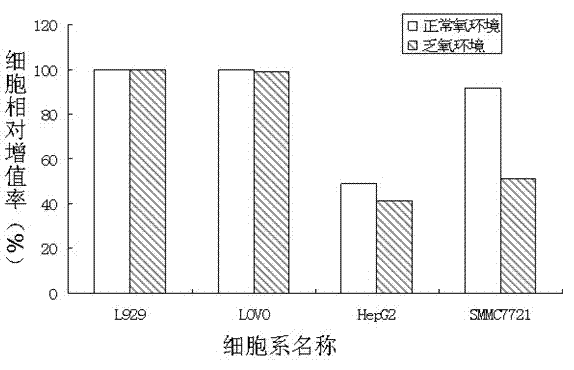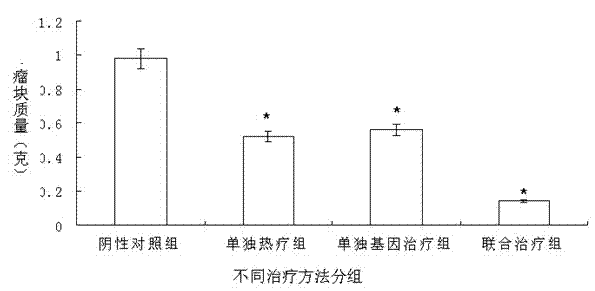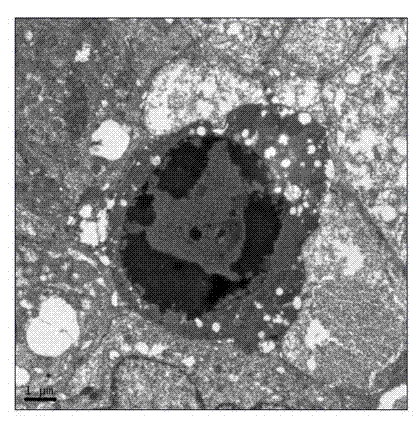Composite magnetic nanoparticles for targeted therapy of liver cancer and preparation method thereof
A magnetic nanoparticle and composite magnetic technology, applied in the field of genetic engineering, can solve the problems of limited number of genes carried, single function of the carrier, and insufficient safety, etc., to achieve a large number of carried genes, good biocompatibility, safety and controllability sex-enhancing effect
- Summary
- Abstract
- Description
- Claims
- Application Information
AI Technical Summary
Problems solved by technology
Method used
Image
Examples
Embodiment 1
[0023] 1. Preparation of Composite Magnetic Nanoparticles
[0024] (1) Preparation of plasmid p[HRE]AFP-p53: p[HRE]AFP-p53 is the name of a recombinant eukaryotic expression plasmid, where HRE refers to the hypoxia response sequence element, which enhances the expression of the plasmid AFP refers to the alpha-fetoprotein promoter, which mediates the downstream tumor suppressor gene p53 (the name of a gene) that can only be expressed in liver cancer cells. The alpha-fetoprotein promoter sequence was prepared by base synthesis, and the two ends of the synthesized sequence contained plasmid restriction endonuclease MluI (MluI is the name of the endonuclease, the same below) and HindIII sites, respectively, and the eukaryotic expression plasmid pCDNA3.1 (pCDNA3.1 is the name of a commonly used gene cloning plasmid, which was first synthesized and applied by Western Biological Company, and there is no corresponding Chinese name at present) and alpha-fetoprotein promoter fragment wi...
Embodiment 2
[0040] The basic steps and process are the same as in Example 1, except that when preparing composite magnetic nanoparticles: the ferroferric oxide magnetic nanoparticles modified with plasmid p[HRE]AFP-p53 and polyethyleneimine are respectively used in serum-free medium Dilute, and then mix the two evenly according to the mass ratio of magnetic nanoparticles to p[HRE]AFP-p53 of 2:1, and obtain composite magnetic nanoparticles for targeted treatment of liver cancer after incubation.
[0041] All the other implementation parts are the same as in Example 1.
Embodiment 3
[0043] The basic steps and process are the same as in Example 1, except that when preparing composite magnetic nanoparticles: the ferroferric oxide magnetic nanoparticles modified with plasmid p[HRE]AFP-p53 and polyethyleneimine are respectively used in serum-free medium Dilute, and then mix the two evenly according to the mass ratio of magnetic nanoparticles to p[HRE]AFP-p53 of 16:1, and obtain the composite magnetic nanoparticles for targeted treatment of liver cancer after incubation.
[0044] All the other implementation parts are the same as in Example 1.
PUM
 Login to View More
Login to View More Abstract
Description
Claims
Application Information
 Login to View More
Login to View More - R&D
- Intellectual Property
- Life Sciences
- Materials
- Tech Scout
- Unparalleled Data Quality
- Higher Quality Content
- 60% Fewer Hallucinations
Browse by: Latest US Patents, China's latest patents, Technical Efficacy Thesaurus, Application Domain, Technology Topic, Popular Technical Reports.
© 2025 PatSnap. All rights reserved.Legal|Privacy policy|Modern Slavery Act Transparency Statement|Sitemap|About US| Contact US: help@patsnap.com



